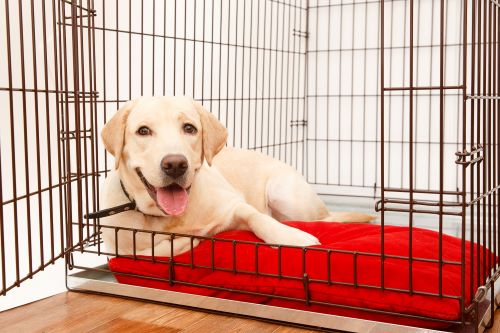The Importance of Crate Training Your Puppy

From the moment you bring your new puppy home, they are rapidly learning and growing. Just like with children, it is important to start teaching them good habits and behaviors early on.
One of the best things you can do for your puppy (and yourself!) is to crate train them. Crate training has many benefits and is relatively easy to do when you know how.
Here at Greenlin Pet Resorts, we want to help you make the most of this important step in your pup’s life, so keep reading for all you need to know about crate training your puppy!
What is Crate Training?
Crate training is the process of getting your puppy used to spending time in their crate. It also involves training the puppy to go into the crate when needed and to act according to a set standard of behaviors once inside the crate. For many puppies, this will be a new experience. They may have never been in a crate before and may not understand why you are putting them in one.
When crate training, it is important to remember that puppies are den animals by nature and that crates can provide them with a sense of safety and security. Crating is not a punishment, nor is it cruel when used correctly in short durations.
When done correctly, crate training can help your puppy become more independent and less anxious overall. It also teaches them self-control, as they will learn to wait patiently for you to let them out instead of engaging in destructive behaviors like chewing on furniture or barking excessively.
The Benefits of Crate Training
There are many benefits of crate training your puppy, both for them and for you as their owner. Some of the benefits include:
-
- Easier Potty Training: One of the main benefits of crate training is that it can make potty training easier for both you and your puppy. When they are confined to a small space, puppies will naturally avoid making a mess where they sleep. This means that they are less likely to have accidents in their crate, which makes potty training simpler and quicker overall.
- Reduced Separation Anxiety: Crate training can also help reduce separation anxiety in puppies. If they know that spending time in their crate is normal and nothing to be afraid of, they will be less likely to feel anxious or stressed when left alone. This can lead to a calmer, happier pup overall!
- Fewer Destructive Behaviors: As we mentioned before, puppies often engage in destructive behaviors like chewing or barking when they are bored or anxious. If you crate train your puppy from a young age, they will learn that being left alone does not have to be a stressful experience. This can help reduce the likelihood of them developing problem behaviors later on.
- Improved confidence and discipline: Many pet owners are surprised to find out that most dogs actually grow to like their crate! It’s a place to call their own, and it instills in them the idea that certain times of the day are for relaxing.
Keep in mind, though, that crate training is not a cure-all for other issues. Dogs should never be crated for more than nine hours a day, says one expert from the ASPCA. Puppies, in particular, should not be expected to remain in their crate for more than four hours at a time.
Crate training should be considered as a component of an everyday routine that includes regular exercise, plenty of potty breaks, and above all else, lots of interaction with owners.
Potty Training With a Crate
One common misconception about crate training is that it should only be used for potty training purposes. However, crates can actually be very beneficial during all stages of potty training, including housebreaking and teaching your puppy not to have accidents inside the house.
When used correctly, crates can help confine your puppy to a small space where they are less likely to have an accident. If possible, place the crate in an area where there is easy access to outdoors so that going from the crate to a potty breaks is quick and easy.
Remember that every dog has its limits when it comes to “holding it,” especially puppies. You should make sure to take your puppy out immediately after they wake up from a nap and after eating or drinking anything so that they can relieve themselves before going back in the crate.
If you need to leave your puppy in their crate for an extended period of time, make sure to provide them with plenty of potty breaks throughout the day. A good rule of thumb is one potty break for every hour that they are crated.
By following these simple tips, you can successfully use crates to potty train your puppy and keep them safe when you’re not able to supervise them!
How to Crate Train Your Puppy
Here are some tips from the experts at Greenlin Pet Resorts on how to successfully crate train your puppy:
- Choose the right size crate. The crate should be big enough for your pup to stand up and turn around in, but not so big that they can use one end as a potty spot.
- Place the crate in an area of the house that’s not isolated and where the family spends a lot of time, such as the living room or kitchen. This will help your pup feel like they’re part of the family pack.
- Introduce your pup to the crate gradually by tossing treats inside or placing their favorite toy inside. Once they’re comfortable going in and out of the crate, you can start closing the door for short periods of time while you’re home with them.
- Crating works better as part of a full routine. If you need to leave your pup home alone, make sure they’ve had plenty of exercise, and put them in their crate with a Kong toy filled with peanut butter or another favorite treat.
- Crate training takes patience, so don’t get discouraged if there are accidents at first. With time and consistency, your pup will get the hang of it!
Let Greenlin Pet Resorts Help Crate Train Your Puppy
If you are considering getting a new puppy, then it is essential that you start crate training early. Crate training is an important part of raising a well-behaved dog, and it is especially important in central Pennsylvania, where winters can be harsh and resources limited.
By teaching your puppy to spend time in a crate from a young age, you will not only help him adjust to life in his new home, but you will also be laying the foundation for successful lifelong training.
At Greenlin Pet Resorts, we specialize in helping pet owners in central Pennsylvania with puppy training. Whether your goal is simple obedience or advanced tricks and commands, our certified puppy trainer professionals can help guide you every step of the way. So if you’re looking for a way to nurture your new puppy’s unique personality while also developing her obedience skills, be sure to reach out to one of six locations in the Harrisburg area today! We can’t wait to work with you and your canine companion!
